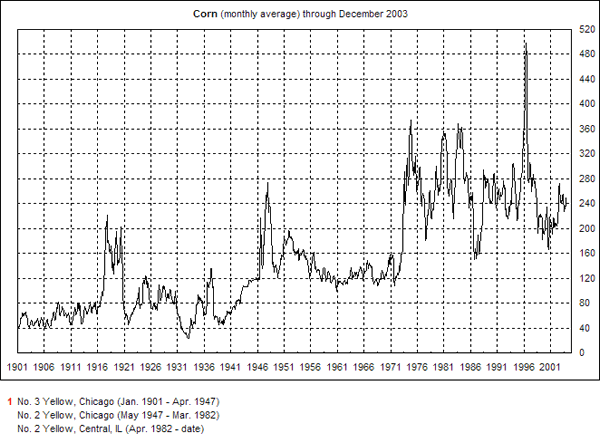|
In 1975, corn prices reached a new high of over $3.60/bushel, marking a dramatic rise that witnessed prices rise 3x in just under 4 years. Today, however, the price of corn has been in a virtual straight line decline that has seen its value drop 40% in nominal terms alone. In real terms, the price of corn is at the lowest point in recorded history.
While commodities often follow boom and bust cycles, the oddity of this particular commodity is quite striking in the fact that 1996 was the only year in which it surpassed its 1975 high. To understand the fundamentals of the industry, we must analyze the key points in both the supply and the demand. The United States is currently the world's leading producer of corn and owns approximately 50% of the export market. While many mid-western states have fertile, arid land that is ripe for corn development, the country did not come about its current power in the industry through a free market. It is the most highly subsidized agricultural product in the marketplace and its continuous oversupply has put a major drag on prices for decades. Year ending stocks on the Chicago Board of Trade are predicted to be approximately 2.5 B bushels, almost 3 months of total production - the highest level its been in over 13 years. At the current time, the majority of corn produced is used to feed animals for slaughter. But because of the huge oversupply in the United States, the country has developed a program to make ethanol from corn, a ridiculous idea that will collapse upon itself as the government becomes less involved (see When Bad Ideas Become Worse Ideas). Currently, the blend of gasoline and corn to make ethanol uses about 12% of the country's output, and although this figure may grow over the next few years, within the next decade it is highly unlikely that corn will be used for this purpose. Those who believe that ethanol production will drive corn prices higher should be cautious. The next largest use for corn is in high fructose corn syrup, used to sweeten food as a substitute for sugar. At the current moment, this market is only stabilized by the system of high import tariffs, quotas, and subsidies placed on sugar. If market prices were to prevail, as they inevitably must one day, corn may find itself losing a large part of this market as well. Finally, the usefulness of corn as a feed for animals (and even humans) is starting to be questioned. It is known to cause problems in the digestive system of animals, especially cattle. The high intake of corn creates an environment in the cattle's stomach which allows the survival of E. coli, a bacteria that is often fatal to human beings if ingested. To combat this problem, cattle are injected with antibiotics, which although the better of two evils, has its own harmful side effects when consumed. Alternative products for animal feed are being researched and it may only be a few years before the standard of animal feed starts to change to a different commodity. Corn may one day make a bounce back up to a reasonable level and perhaps even to new highs, but huge problems for corn exist in the long run. It is fighting to hold onto its 3 biggest markets and its stock levels are the highest in history. The Commodity Investor expects prices may hit around the $1.75/bushel mark before going higher.oing higher in the medium term. Until then, we recommend steering clear of corn. |


